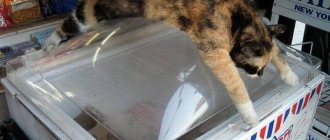When you're traveling with an outdoor cat, it's important to know how far you can push her to her limit before she becomes potentially dangerous. So, exactly how much cold can cats tolerate?
A good rule of thumb is that if your cat is healthy, any temperature above freezing should be safe. There are many different climates in the world. You may live in a warmer part of the world, but that doesn't mean your cat won't encounter dangerously cold weather.
Here are some frequently asked questions and some tips about cold weather and cats.
How do cats survive the winter cold?
A pampered domestic cat freezes at the slightest drop in temperature, but surviving a harsh winter is not a problem for such pets, because they have loving owners and a warm home.
shutterstock
It is much more difficult in winter for homeless animals who are forced to take care of themselves. Dogs survive the winter by huddling in packs or digging deep holes in the snow. Cats do not know how to dig holes and, being solitary by nature, avoid the company of other representatives of their kind. Therefore, in order to survive the winter, cats had to invent their own ways of survival.
Preparing cats for winter:
- Thick and long hair provides cats with excellent protection from the cold, so in winter, animals stop shedding;
- Outdoor cats actively hunt mice and other rodents in the fall in order to stock up on fat, which helps them stay warm in severe frosts;
- Another interesting fact: in winter, cats hardly wash themselves, since with wet fur the animals are more susceptible to the cold;
- To survive severe frosts, stray cats look for suitable shelter in advance. Usually, porches, warm basements or abandoned houses become shelters for animals.
How cats prepare for cold weather
Cats are not as sensitive to temperature changes as humans, thanks to their fluffy and thick fur coat.
It’s no secret that cats gain several kilograms of excess weight during the winter. In this case, owners do not need to sound the alarm and put their pet on a strict diet.
In this way, the animal prepares itself for winter, and does this on a subconscious level, thanks to genetic memory, when cats still walked on their own and were forced to take care of themselves.
All cats gain several kilograms of excess weight during the winter.
The fur of these creatures also becomes a little thicker and longer in winter and, remarkably, cats practically do not shed in winter.
Another interesting fact is that cats rarely bathe in winter, and this is due to the fact that wet fur is unable to protect them from the cold.
At what temperature can a cat walk outside?
Cats are one of the hardiest animals, and these creatures live on almost all continents, so most of them are perfectly adapted to cold climates.
Most cats tolerate cold climates well.
Thick wool and dense undercoat perfectly protect animals from cold and frost and thanks to them the cat almost does not freeze.
Extremely negative temperatures
But don't think that a cat can survive in extreme subzero temperatures. If she stays in the cold for a long time at minus twenty degrees, then this can end disastrously for her: the animal will freeze its paw pads and ears, which are almost devoid of fur.
A cat cannot survive in extremely low temperatures!
Unfortunately, not all cats are lucky enough to have a home and loving owners. Homeless animals are forced to survive in the winter, taking refuge in hallways, basements or abandoned houses.
What to do if your cat is cold
If your cat is cold, you need to wrap it in a warm towel.
As a rule, a cold cat will instinctively look for the warmest place in the house, for example, near a radiator or electric fireplace. Many animals can crawl under a warm blanket or blanket.
What you should absolutely not do in this case is bathe your pet. A hot bath will not only not help, but will also cause your pet to freeze even more after it and may even catch a severe cold.
How to help a frozen animal?
If your four-legged pet is very cold, you need to start normalizing its body temperature as quickly as possible. In some cases, the slightest delay can cost the animal its life. The actions of the owner of a frozen pet are as follows:
- Wrap the cat in a warm blanket or terry towel. To warm it up faster, you must first hold the blanket on the radiator.
- Place your four-legged pet wrapped in a blanket on a bed near the radiator. Other sources of heat would be useful - heating pads, bottles of hot water, which should be placed around the four-legged frostbite.
- Close all windows and doors in the room in which the frozen animal is located. There should be no drafts in it.
- Dry your pet's fur with a hairdryer if it gets wet in the rain or snow.
- Stay close to the cat until it warms up.
- Feed the warmed animal warm, preferably liquid food.
What you should not do in this situation is try to warm your four-legged pet in hot water. Water procedures in this state are strictly contraindicated for him. He will only freeze even more and may get a serious cold.
In case of severe frostbite, veterinary attention is required. A frostbitten four-legged patient will be prescribed IVs with warm solutions, warm pleural lavage, the use of a ventilator to normalize body temperature, and the use of analgesic veterinary medications that relieve pain while restoring tissue sensitivity. Subsequently, a comprehensive examination of the pet will be required to assess the condition of the internal organs.
At what temperature does a cat start to freeze?
Cats are one of the hardiest representatives of the fauna. They live on almost all continents, so most of them are adapted to the harshest conditions. However, one should not overestimate the ability of a cat’s body to easily tolerate sub-zero temperatures.
Thick fur, dense undercoat and a thick layer of subcutaneous fat allow these animals to walk outside without freezing when the thermometer drops to 5–10° below zero. They feel quite comfortable even at minus 15–20°, provided that the walk is short. If you stay outside for a long time in such frost, your cat may become hypothermic. In addition, she can freeze her ears and paw pads, which are devoid of fur.
It is believed that representatives of the cat family are able to survive at temperatures of -30°. However, in reality this is not at all the case. In such frosty weather they are not only cold, they can die from hypothermia.
Are there freezing cats?
The owners of such pets confidently answer – yes! Of course, pampered animals who only look outside from the window and then with longing, dreaming of the summer sun, freeze more often. In addition, some breeds are naturally thermophilic, especially if their origin is associated with warm regions. Such cats will huddle close to heating devices and ask for a blanket, even when there is no question of cold. Owners of such pets note that in winter their pets sleep more and move much less.
Another factor influencing the “freezing” of cats is their age. Kittens tolerate low temperatures less well due to imperfect thermoregulation mechanisms. A similar phenomenon is observed in elderly animals - their body, alas, no longer works “like a clock.”
In addition, unhealthy cats begin to freeze faster - those suffering from a disease, recovering from an illness or surgery, having a weak immune system or being very thin and lacking body fat.
Accessories, tools and methods
If the above methods do not help protect your cat from the heat, you may want to try additional methods. The cat will feel better if its physical activity is reduced as much as possible, so bowls, a tray and a bed should be placed in the same room.
Once you're sure your cat is completely healthy, you can use homemade ice cream as an extreme coolant. Naturally, the product is contraindicated for cats with lactose intolerance and should not contain sugar. Ice cream is fed to the cat from a teaspoon in a slightly melted state.
Many owners decide to cut their cat's hair to ease its suffering. Grooming as a method is not prohibited, but as mentioned above, a pet cannot be cut to zero. The more important point is combing. By summer, the cat's undercoat (if any) is completely shed and must be thoroughly combed out. The higher the air temperature becomes, the coarser the pet's fur will become and this is normal. In the process of increasing the stiffness of the guard hair, the cat may lose a small part of the old hair, this is also normal.
Even if your pet doesn't like water, place a small bathtub freely accessible. Cats are not afraid of water, but they do not get into it unless necessary. Increased air temperature is the most natural need to wet the wool known in nature.
Modern industry keeps pace with progress. Today, in almost any large store, you can purchase cooling accessories for animals. For dogs, the range is wider; suits and paw muffs are sold. For cats, the range is currently limited only to cooling bedding and collars. The accessories are filled with hydrogel, which not only holds water, but also maintains a low temperature. Before use, the accessory is placed in a container of water for the time specified in the instructions. Typically, cooling accessories maintain a cooling effect for 1-3 days and last 2-4 years.
Behavior of cats in winter
Most cat owners notice that with the onset of the first cold weather, their pets behave completely differently than in the warm season. Even the most playful and active animals turn into lazy couch potatoes who spend most of their time on the sofa or near a warm radiator.
It should also be noted that all felines have an increased appetite in winter, as a result of which the pets noticeably gain weight, gaining a few extra pounds. Cats do this on a subconscious level, because their genetic memory tells them that a layer of subcutaneous fat helps them survive in winter frosts.
shutterstock
Some owners are worried about this and begin to limit the cat's food, fearing that the pet's excessive appetite can lead to obesity. But such fears are completely in vain, because with the onset of spring, the animal’s need for an additional portion of food will disappear, and the pet’s weight will return to normal.
At what temperature can cats live outside?
Animals, in particular cats, are not as sensitive to temperature changes as people, thanks to their fluffy and thick fur coat.
Many pets that their owners let out for walks ask to go outside in any weather, and a cold frosty winter is no exception.
But, if in the warm season the owners do not worry about the health of their furry pets, then in the bitter cold they are a little afraid to let them outside.
Are there any grounds for such fears and what sub-zero temperatures can cats withstand without freezing or frostbiting their paws or ears?
How cats prepare for cold weather
Cats are not as sensitive to temperature changes as humans, thanks to their fluffy and thick fur coat.
It’s no secret that cats gain several kilograms of excess weight during the winter. In this case, owners do not need to sound the alarm and put their pet on a strict diet.
In this way, the animal prepares itself for winter, and does this on a subconscious level, thanks to genetic memory, when cats still walked on their own and were forced to take care of themselves.
All cats gain several kilograms of excess weight during the winter.
Another interesting fact is that cats rarely bathe in winter, and this is due to the fact that wet fur is unable to protect them from the cold.
At what temperature can a cat walk outside?
Cats are one of the hardiest animals, and these creatures live on almost all continents, so most of them are perfectly adapted to cold climates.
Most cats tolerate cold climates well.
A cat can safely walk outside, even if the thermometer shows ten to fifteen degrees below zero.
Thick wool and dense undercoat perfectly protect animals from cold and frost and thanks to them the cat almost does not freeze.
Extremely negative temperatures
But don't think that a cat can survive in extreme subzero temperatures. If she stays in the cold for a long time at minus twenty degrees, then this can end disastrously for her: the animal will freeze its paw pads and ears, which are almost devoid of fur.
Most experts claim that cats can survive at temperatures as low as minus thirty-five degrees, but this is not true.
A cat cannot survive in extremely low temperatures!
Unfortunately, not all cats are lucky enough to have a home and loving owners. Homeless animals are forced to survive in the winter, taking refuge in hallways, basements or abandoned houses.
What to do if your cat is cold
If the pet is too carried away by a walk in severe frost, then in order to save the cat from hypothermia, it should be immediately wrapped in a warm terry towel.
If your cat is cold, you need to wrap it in a warm towel.
As a rule, a cold cat will instinctively look for the warmest place in the house, for example, near a radiator or electric fireplace. Many animals can crawl under a warm blanket or blanket.
What you should absolutely not do in this case is bathe your pet. A hot bath will not only not help, but will also cause your pet to freeze even more after it and may even catch a severe cold.
What cat breeds can't stand the cold?
Oriental cat breeds are extremely heat-loving and will not go outside in the cold.
It is clear that such fluffy cats as Siberian, Maine Coons or Norwegian Forest cats, thanks to their luxurious fur coat, can stay outside for a long time in winter.
But eastern breeds, for example, Abyssinians, Persians or Burmese cats, are extremely heat-loving and for them even five degrees below zero is a good reason not to leave the house.
At what temperature do hairless cats die?
There can be no question of releasing hairless cats in winter! Such exotic pets as “sphinxes” or “bambinos” get very cold and if the animal is outside at sub-zero temperatures, it will certainly die.
Hairless cats should not be allowed outside in winter!
Cold is also poorly tolerated by small kittens, elderly animals, pregnant cats or those suffering from any disease. It is strictly forbidden to let them outside in winter.
In winter, you should be especially careful about your pet and it is advisable to walk him on a leash. After all, if a cat gets lost and cannot find its way home, then it is likely that in severe frost it may die from hypothermia.
Helping your pet with hypothermia
Many cats love to walk in winter, play with snow and catch snowflakes. Sometimes the pet gets too carried away with the walk and when he comes home he is shaking all over from the cold. What should the owner do in this case, and how to help the pet warm up faster?
?
- First of all, the animal must be wrapped in a thick towel or warm blanket;
- A frozen cat will try to warm up near a radiator or fireplace, so you should place its house or bedding near them;
- It is necessary to ensure that there are no drafts in the house, as the pet may catch a cold;
- You can dry your cat's wet fur with a hairdryer;
- Bathing in warm water will not warm the cat, but will cause it to freeze even more, so bathing the animal is extremely undesirable.
Cat at home
Cats sleep more than usual in winter; they try to lie down on the radiator or hide under a blanket. The range of temperatures comfortable for cats ranges from 20 to 25 degrees. Hairless sphinxes and representatives of breeds without undercoat are more sensitive to low temperatures and drafts compared to their counterparts with a long coat and a full undercoat.
The fact that the cat is cold is indicated by muscle tremors and cold paws, which she tries to tuck under herself. The cat tries to climb into a warm place, for example, lie down on a heating pipe or crawl under a blanket. Long-haired cats need to be carefully looked after and not allowed to get their fur into tangles, which interfere with proper heat exchange. For freezing cats with poor fur, we can recommend purchasing clothes that are made specifically for pets. “Warm mats” for cats are also available for sale. They come in several types of action. There are electric rugs that operate with a continuous supply of electric current, there are those that heat up only when the animal lies on it and closes the contact with its own weight, and there are those that need to be preheated in a UHF oven. The latter, depending on the model, give off heat for 10-72 hours.
Many owners keep cats in winter and summer only at home; they are not allowed outside, thus solving the problems of possible infection by stray animals, loss of a pet, and unwanted matings.
Caring for a cat in winter
You can determine that a cat is cold by several signs. The animal begins to tremble, its paws become cold and the pet pulls them under itself. The animal persistently climbs into the warmest place.
At low temperatures, the animal’s joints become especially sensitive, and older cats are the ones who suffer the most from this.
Therefore, it is important to make it easier for your pet to move around, which involves jumping or jumping, to help move from a height to the floor or from the floor to a sofa by installing special stairs and ramps.
If your pet has long hair, then it is better to take care of it more carefully, avoiding the formation of tangles.
If the coat is not rich, clothing specially made for pets will help out. There are even “warm mats” of different types of action:
- electric with continuous current supply;
- heated when the contact is closed from the weight of the animal lying on the rug;
- heated in microwave ovens.
Other useful tips
A pet that eats high-quality, balanced food will survive sub-zero temperatures much easier. When cold weather sets in, energy costs for heating increase
Therefore, it is recommended to pay attention to the diet, especially for kittens and older cats. In winter, it is necessary to increase the calorie content of the menu, add complete proteins and fats
These substances are found in sufficient quantities in meat and dairy products.
Homeless animals rarely eat healthy food, so it is natural that not all will survive in the cold and severe frosts. Therefore, if abandoned cats live in the yard or nearby, you should try to help them cope with bad weather. You can feed the strays with leftover food or give them inexpensive dry food. Particularly compassionate cat lovers make them a primitive shelter where the animal can hide from snow, wind and severe frost. But if the cat is cold and all the signs of hypothermia are visible, you should not leave it to suffer outside, because the body will not stand it. A rescued animal can become a new member of the family and find caring and loving owners.
Wintering at the dacha: how to organize a shelter for a cat?
If your cat will live at the dacha in winter, you must do everything to prevent it from freezing. For this you will need a cat house. You can buy it ready-made or make it yourself. This design should be:
- Raised above the ground. You can raise it by simply placing a few bricks, an old pallet or any other unnecessary item under it.
- The outside is equipped with a waterproofing layer that will protect the cat house from rain, snow and other precipitation.
To prevent the animal from freezing inside, the house should be insulated. You can do this in 2 ways:
- cover the walls, ceiling and floor with insulation (for example, polystyrene foam);
- equip the building with heating.
In addition, it is recommended to place a warm bed at the bottom of the room and make the door lockable. The wintering house should not be too spacious, otherwise its occupant will not be able to warm the interior space, since it is the animal whose body produces heat that acts as its main heating system. However, it should not be too small either. In cramped conditions the cat will simply feel uncomfortable.
Freezing at home?
Usually the temperature in the apartment does not drop so low that the cat can actually freeze. But many owners pamper their kittens by teaching them to sleep near the radiator or under a blanket. Growing up, the pet does not tolerate even a slight drop in temperature: it trembles, clings to the warmth, the cat has cold paws and ears, and loses interest in games. As mentioned above, some cats love warmth from birth, and manage to freeze at room temperature that is quite comfortable even for humans. Sick and aging cats are freezing, kittens and pregnant pets are looking for warmth.
Creating comfortable conditions is very simple. You need to purchase a couple of closed houses or sun loungers with high sides. Inside you can put an old woolen sweater, some kind of fur bag or a baby blanket. The cozy nest should be located near the radiator, but so that the sides of the “dwelling” do not touch it. And, of course, we must not forget about proper feeding, vitamins and monitoring the general condition of the pet.
Does a cat's fur keep her warm?
Sphynx cats definitely get cold, but what about cats with fur? Pets with a dense, well-developed undercoat are most fortunate in terms of insulation. It is designed to retain natural heat, maintaining the animal's normal body temperature for a long time.
But, as in the case of human clothing, such protection does not last forever: if a person, even warmly dressed, after spending some time in the cold, begins to feel cold, the same happens with cats. If we talk about the temperature at which animals begin to freeze, then everything depends not only on the thermometer readings, but also on other factors:
- whether the pet is in motion or sitting still;
- what is the air humidity;
- is there any wind;
- whether the sun is shining or cloudy, etc.
In “dry” frost, cats do not feel the cold longer, and if the pet does not move, it begins to freeze quickly. With increased humidity, the pet freezes even faster. Practically, in this aspect, everything happens the same as in humans, but with one clarification - cats are superior to people in endurance.
Representatives of hairless breeds and breeds without undercoat are less resistant to low temperatures than cats with “shaggy” coats. Streams of cold air quickly penetrate the skin, but the heat is not retained. When such pets freeze, their ears and limbs become cold, even if the walk does not last long and the thermometer shows a temperature of at least -15°C.
But Maine Coons, Siberians and other cats with good coat protection, especially if they are not too pampered, can safely walk even at -25 - -30°C.
Video about how a cat was rescued in severe frost
Of course it's freezing! It is absurd to think that since a cat is originally a wild animal, it can easily and easily adapt to frost and winter cold. Even the super woolly indoor cat needs the warmth of the hearth in winter.
Observing our pets, we come to the conclusion that even at room temperature, cats find a place where it is warmer - and it is there that they curl up and rest. What can we say about frosts?
What temperature can cats withstand in winter?
The answer to this question cannot be universal for all Muroks and Murzikovs. Some experts do not recommend walking at -20°C. But this is a very relative parameter. Because there are a lot of factors that affect the “winter hardiness” of each individual animal.
Breed. It’s easier for mongrels, but for sphinxes, for example, it will be cold even at +10°C.
Wool, presence or absence of undercoat.
Habit. There are representatives who walk around their property in any weather, especially in the villages, few people bother with cats and cats. But our village man managed to get a slight frostbite in his ear - and it’s simply impossible to keep him in the house. And there weren’t even any significant frosts...
Age. Kittens and old animals cannot keep their body temperature constant.
General health. Hidden diseases, pregnancy in cats weakens the animal and its resistance to low temperatures decreases.
Cats and cats in the snow in winter - photo story
The woolen outfit and natural endurance are reassuring, but looking at your pet meowing under the door, you can’t help but think: “Do cats freeze in winter? Isn’t Vaska’s passion for running through freshly fallen snow dangerous?” You can understand whether a cat is cold only by observation, because our pets differ from each other not only in eye color and taste preferences. How do cats cope with the cold and how can you tell if the ambient temperature is not making the furry explorer happy?
Although why furry? There are also hairless cats, smooth, completely devoid of hair. It is clear that such a cat freezes at sub-zero temperatures, quickly releasing the accumulated heat. Letting a sphinx go for a walk in sub-zero temperatures is an unthinkable idea, the consequences of which can be very disastrous. If your pet is accustomed to walking or if a naked cat is cold even in an apartment, you can put sweaters and overalls on it. Of course, the fabric warms worse than a real fur coat, so walks should not be long: your paws are shaking, your ears are cold - go home and warm up. At what temperature does a naked cat freeze? As a rule, sphinxes experience discomfort even at +10°C, not to mention sub-zero temperatures.
But let's get back to the cats sporting luxurious fur coats. The coat can be long or short, but if it is two-layered, with a well-developed undercoat, are cats cold in winter? The undercoat retains heat well and prevents overheating, keeping body temperature within normal limits. However, such protection is not endless: just as a person dressed in a doha, earflaps and felt boots will still freeze after a few hours spent on a frosty street, so a cat, “wrapped” in the best fur, will sooner or later begin to freeze. At what temperature do fluffy cats freeze depends not only on the thermometer readings, but also on the actions of the pet, air humidity and other nuances. “Dry” frost is easier to bear; with low activity you freeze faster; increased humidity means you feel the cold more clearly. Everything is like in humans, with an adjustment for cat endurance.
Cats without undercoat freeze faster than Siberians, Coons and representatives of other “furry” breeds. Cold air penetrates the skin faster, heat leaves faster. These cats have cold paws and ears even after short walks at -15 Celsius. But a Siberian, not pampered by life in the arms of a radiator, can walk for a couple of hours without danger to health, even at -30°C.
What is hypothermia?
Hypothermia is a severe pathological condition that is caused by a decrease in the cat’s body temperature below the minimum acceptable level. Note that the normal body temperature of a healthy adult cat varies from 38 to 39°C. In kittens, this indicator ranges from 38.5 to 39.5°C, with short-term jumps up to 40°C being acceptable. This is due to the imperfection of their thermoregulation center, which has not yet had time to “tune in.”
The main physiological mechanism that is triggered when an animal or person is cold is involuntary muscle contraction (shivering). Since the body of cats is covered with fur (although not in all breeds), they suffer less from the cold than humans, but still they are very far from the animals of the Arctic.
The maximum risk of developing hypothermia is created in conditions when it is not only cold outside, but also humid. If the animal's fur is moisturized, there is no air gap between the hairs, resulting in the cat being “naked.” In this condition, your pet is especially susceptible to developing hypothermia. What other categories of animals are most likely to develop this pathological condition?
These are the oldest cats and small kittens. Due to age (excessively large or small), their thermoregulation system malfunctions and cannot maintain a stable body temperature. That is why “oldies” and small kittens should always be kept in comfortable conditions. It is generally not advisable to let old cats outside in winter and autumn.
Frosty cat
This one-year-old cat received the nickname “Frosty” (from the English Frost - frost) due to the fact that he lived for more than a month in a warehouse of frozen semi-finished products, which is essentially a huge refrigerator. This happened in England, in the county of Northamptonshire in the winter of 2010. The “frosty” cat arrived at the warehouse on a truck (he was looking for a warm place to rest) along with packages of carrots and peas. In the warehouse, he ate frozen food for four weeks and licked moisture from the walls. The polar explorer was, against his will, not immediately able to be caught. When this happened, he was taken to RSPCA Woodside, an animal center in Leicestershire. The cat lost his frostbitten tail and ears, but was quite healthy. One of the warehouse workers took the lucky one to his home, and his colleagues raised money for veterinary treatment. (from Gazeta.Ru materials with reference to The Sun)
( 15 ratings, average: 4.27 out of 5)
Cat walking by itself
A cat that regularly walks outside for a long time is quite hardened and has enough skills not to freeze. If a cat has the opportunity to freely walk outside in winter, when it freezes, it will definitely hide in a shelter or ask to go home. The thick undercoat will prevent the cat from freezing even in ten-degree frosts. But, of course, this only applies to healthy animals with sufficient body weight. But it is not recommended to suddenly take kittens and non-hardened cats out for their first walk in the winter cold - the animal may catch a cold. Therefore, if you got a pet in the warm season of the year, and you decided that the cat will be walked, you should not waste time - give the cat the opportunity to get used to the natural decrease in ambient temperature, regularly let it out for a walk, in this case the winter cold will not will come as a shock to her. If a cat appears in your apartment in winter, do not risk its health - be patient with walks until the spring sun.
Recently, in large cities, the problem of protecting cats’ paws from reagents, which are generously sprinkled on sidewalks and roads in winter, has become urgent.
Reagents, no matter whether they are acids or ordinary table salt, corrode the delicate skin of a cat’s paw and cause burns. To prevent such injuries, it is recommended to treat paws with products that create a protective layer on the skin before walking.
These special waxes, creams, gels, and sprays will protect paws not only from the negative effects of deicing agents, but also from the effects of fuel oil and gasoline, and protect them from frostbite and microtrauma. The product is applied to the skin of the pads and fingers before each walk. When the cat returns home, the paws should be washed with warm water and dried. You can buy such products in pet stores and veterinary pharmacies.
Frostbite
The cat's paw pads, tail and ear tips are most sensitive to low temperatures.
Superficial frostbite affects only the skin and subcutaneous tissues, which initially turn pale. As blood circulation is restored, the skin turns red, swells and peels. More severe frostbite causes blisters with clear or milky fluid. Frostbitten areas are bordered by a clear line of demarcation from living tissue.
Deep frostbite is characterized by death of the skin, subcutaneous tissue and muscles. In especially severe cases, tendons and bones may be affected, and tissue rejection to a great depth may be observed. First, blisters containing blood form, which turn into black scabs within two weeks. Deep frostbite leads to complete necrosis (death) and tissue loss.
If sensitivity and normal skin color remain in the affected area, and if pressure is applied to it, a hole remains, the prognosis is favorable.
If the skin feels wooden to the touch, has bluish lesions and blisters with blood, and there is no trace left on it after pressure, tissue necrosis is possible. What to do? The affected area should not be rubbed, especially with snow, so as not to damage the tissue further and cause infection.
You can quickly warm the affected area by soaking it in warm (not hot!) water or constantly applying a warm, damp towel to it and lightly massaging (without rubbing) until the tissues become red. Then carefully dry and apply a loose bandage. For further treatment, it is better to contact a veterinarian. For superficial frostbite, you can use the “Rescuer” balm, protecting the affected area from licking (for example, using a protective collar).
Blisters with clear fluid are opened and an anti-prostaglandin drug (such as aloe vera juice) is applied. Hemorrhagic (blood mixed) blisters are not touched. The animal is prescribed non-steroidal anti-inflammatory drugs, drugs to improve blood circulation, and antibiotics to prevent infection. Dead tissue is removed surgically.
Symptoms of hypothermia
What are the symptoms of hypothermia in cats? They largely depend on how far the pathological process has progressed. In most cases, the following clinical signs can be observed:
- Severe and uncontrollable shaking. But it only happens in mild cases of hypothermia. So if you notice that your pet is literally “shaking” from the cold, you can consider him lucky.
- If you put your hand on the skin on a cat's belly, you can feel the cold coming from it. Since the abdomen and groin area are usually the warmest under normal conditions, this simple test is very revealing.
- Apathy, the cat tries to hide in the farthest corner and does not come out, even to eat.
- Lethargy.
- Drowsiness.
- Decreased rectal temperature. This is a very dangerous symptom, since under normal conditions the temperature in the rectum is approximately 0.5-1°C higher than when measured in the ear or mouth. This is observed only in severe forms of hypothermia, in which case it is strongly recommended to immediately show the animal to an experienced veterinarian.
- Slow and shallow breathing.
- Slow heartbeat (bradycardia).
- Inappropriate behavior.
- Coma.
- Death.
Diagnosing hypothermia is quite simple. Firstly, the veterinarian will focus on the clinical picture of the pathology that we described above. Second, he will check your rectal temperature. The lower it is compared to the norm, the faster the animal needs to receive qualified medical care.
How can you tell if a kitten or adult cat is cold?
The condition of the body in which the body temperature drops below that required to maintain life processes is called hypothermia. The following symptoms indicate it:
- chills;
- shiver;
- weakness and lethargy;
- pallor of mucous membranes;
- body temperature below 36°.
Prolonged hypothermia of the body of a kitten or adult cat leads to a decrease in the concentration of glucose in the blood. The pet's muscles freeze, heart rate and breathing slow down, and it stops responding to external stimuli. As the animal's condition worsens, the animal collapses, which turns into a coma. If the body is too hypothermic, the cat may appear dead, because its pulse and heartbeat cannot be heard.
Cat thermoregulation - features you need to know
Most four-legged animals love warmth and gravitate towards the sun's rays even in summer. Cats are naturally hotter than humans, so they expend much more energy to keep their bodies warm. Being warm, the cat feels much more comfortable and calmer because it saves energy.
Despite their versatility in terms of preserving vitality, cats also have weaknesses. With a normal body temperature of 38–39°, cats are much more sensitive to changes in air temperature. Cats don't sweat, so they can't cool down quickly. Dogs, in order to cool themselves in the heat, breathe with their mouths open, while cats open their mouths when their heart muscle is working to the limit or severe oxygen starvation has developed.
Diet
Cats naturally lose their appetite in hot weather, which is not a concern for you or your family. The pet does not need to be persuaded to eat, much less force-fed. At high temperatures, a cat can remain absolutely hungry for about a day, a kitten for no more than 12 hours. Naturally, your task is to make sure that the cat drinks enough water and visually looks healthy.
Meal times should be moved to earlier in the morning or late evening. It is advisable, during extremely high temperatures, to switch the cat to a single meal and feed the pet in the evening. At night, when the air temperature drops, the cat needs energy to stay warm. During the day, it will be difficult for the patient to cope not only with the heat, but also with digesting food.
With a natural diet, all heavy foods should be excluded from the diet, and the amount of grains should be kept to a minimum. Beef, pork (if you give it to a cat), lamb should be replaced with rabbit, chicken or quail meat. Remove food from the bowl as soon as the cat is satisfied, because in the heat, it will take several hours for the food to disappear and there is a risk of poisoning.
But how then do street murks survive?
It's terrible, but not everyone survives. Even hereditary stray cats are not able to withstand frosts below 20°C for long. Pack dogs gather closer together, warming each other, and dig holes in the snow. Cats do not know how to dig holes, and do not flock together
If you doubt whether cats are cold in winter, pay attention to how few familiar faces you meet when going to work in the morning: in the summer there is a mug under every car and on every bench, in winter they all disappear somewhere.
Somewhere - these are, as a rule, basements and entrances. Although in recent years, many basements have been tightly sealed, and ordinary doors have been replaced with metal ones with an electronic lock. Of course, from a sanitation point of view, populating basements with stray cats is not the best solution, but for many cats this is the only chance to survive the winter.
What is it like for street cats?
In fact, they have a hard time and even the most wind- and frost-hardened cats are not always able to withstand the winter period, especially if it has been frosty for a long time.
In such a situation, it is much easier for dogs to survive the winter - they know how to tear up the ground or snow, constructing holes and rookeries. They are also pack animals and can keep each other warm by huddling closely together. Cats are loners, so not all of them survive the winter.
If in summer you can see a lot of murkas on the street, then in winter they are practically invisible. If you're lucky, they make their home in basements or attics.











